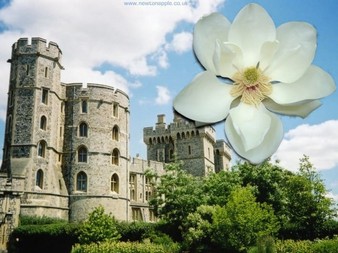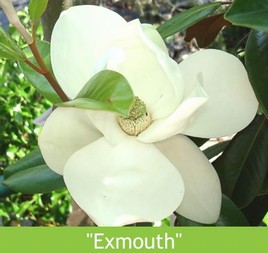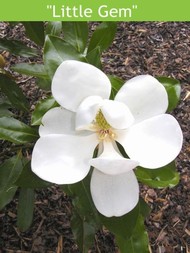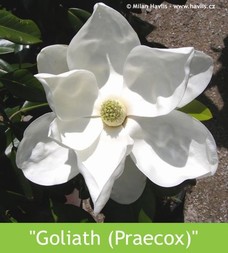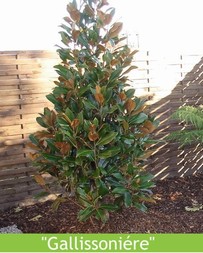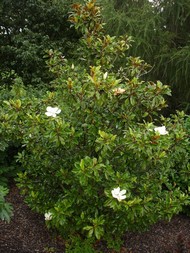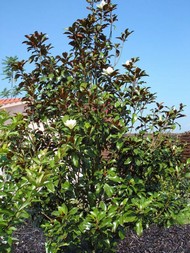 At that moment I decided that I had to have a magnolia like that. My guide just grinned and with English pride in his eyes warned me that this plant was too delicate to withstand the Czech frosts and that only they could have it in England where it hardly freezes. He had no idea how far I would go to convince him otherwise. It really took several years before I managed to get sources from enthusiastic admirers and growers of this plant in inhospitable conditions rather than encyclopaedic data, which generally exclude its existence in countries where frosts drop below -15°C. Very briefly, luck has been with me and the history of the search for this pride of summer gardens for our climate has borne fruit. And after a few years of trying and test plantings, we have the results. What are they? Positive!
At that moment I decided that I had to have a magnolia like that. My guide just grinned and with English pride in his eyes warned me that this plant was too delicate to withstand the Czech frosts and that only they could have it in England where it hardly freezes. He had no idea how far I would go to convince him otherwise. It really took several years before I managed to get sources from enthusiastic admirers and growers of this plant in inhospitable conditions rather than encyclopaedic data, which generally exclude its existence in countries where frosts drop below -15°C. Very briefly, luck has been with me and the history of the search for this pride of summer gardens for our climate has borne fruit. And after a few years of trying and test plantings, we have the results. What are they? Positive!
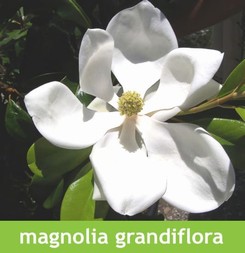 It is our great honour to present the most beautiful flowering tree on the planet for temperate climates, the magnolia grandiflora. In English nomenclature it is also called the Southern or Californian magnolia. It is a medium-sized tree in our country, but a tall and wide specimen in its native land. The leaves are dark green, extremely glossy, evergreen, and covered with reddish-brown hairs underneath. The flowers are showy, with 9-12 snowy, later to creamy white petals, and are huge: 15-30 cm across (depending on the species). It is native to the southeastern coast of the USA, where its natural range extends into central California. It is therefore called 'southern' and until recently was the preserve of countries with warm winters and sunny, hot summers. But it would be the devil if something hadn't happened to shuffle the cards a bit. In the northern part of the USA, deciduous magnolias, similar to those we are used to seeing in spring here, grow naturally. A few species even have flowers similar to this southern species.
It is our great honour to present the most beautiful flowering tree on the planet for temperate climates, the magnolia grandiflora. In English nomenclature it is also called the Southern or Californian magnolia. It is a medium-sized tree in our country, but a tall and wide specimen in its native land. The leaves are dark green, extremely glossy, evergreen, and covered with reddish-brown hairs underneath. The flowers are showy, with 9-12 snowy, later to creamy white petals, and are huge: 15-30 cm across (depending on the species). It is native to the southeastern coast of the USA, where its natural range extends into central California. It is therefore called 'southern' and until recently was the preserve of countries with warm winters and sunny, hot summers. But it would be the devil if something hadn't happened to shuffle the cards a bit. In the northern part of the USA, deciduous magnolias, similar to those we are used to seeing in spring here, grow naturally. A few species even have flowers similar to this southern species.
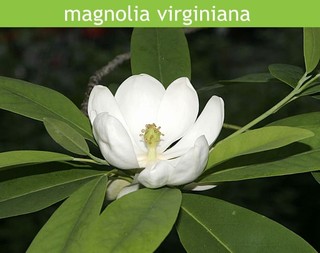 It is thought that over the many years, as the magnolia's range has progressed higher north along the east coast, a hybrid between the deciduous and the non-deciduous species has naturally developed. This hybrid was found in the state of Virginia, hence the name magnolia virginiana. The moist, almost swamp-loving plant has evergreen leaves and white flowers and can withstand much harder frosts than it is used to in its native country. It therefore became the basis for research into its characteristics, and the results were used to breed a much more beautiful fellow plant, the magnolia grandiflora, so that the hardiness of the virginiana could be instilled in the grandiflora.
It is thought that over the many years, as the magnolia's range has progressed higher north along the east coast, a hybrid between the deciduous and the non-deciduous species has naturally developed. This hybrid was found in the state of Virginia, hence the name magnolia virginiana. The moist, almost swamp-loving plant has evergreen leaves and white flowers and can withstand much harder frosts than it is used to in its native country. It therefore became the basis for research into its characteristics, and the results were used to breed a much more beautiful fellow plant, the magnolia grandiflora, so that the hardiness of the virginiana could be instilled in the grandiflora.
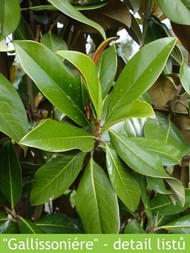 None of the growers have boasted exactly how they achieved their result, but varieties have begun to appear on the market that are able to survive varying degrees of frost and, moreover, with minimal loss of foliage over the winter. More than 150 years ago, a plant was imported from the USA to Europe, specifically France, which thrived in colder regions and became a sought-after commodity not only in the Mediterranean but also in the warmer areas of continental Europe. It was named 'Gallissonniére' after a French governor in Canada in the 18th century. It may well be the one that adorns Windsor Castle, as it has also been successfully cultivated in England and Ireland. In Italy, alongside the slender, tall cypresses, this species is an unmistakable symbol of Tuscany. In almost every garden you will find at least one, usually pruned into cones or subtle shapes to achieve maximum effect in a small space. It has large leaves to the tip and large flowers, its reliable hardiness is about -20°C and you will encounter it even at the foot of the Italian Alps.
None of the growers have boasted exactly how they achieved their result, but varieties have begun to appear on the market that are able to survive varying degrees of frost and, moreover, with minimal loss of foliage over the winter. More than 150 years ago, a plant was imported from the USA to Europe, specifically France, which thrived in colder regions and became a sought-after commodity not only in the Mediterranean but also in the warmer areas of continental Europe. It was named 'Gallissonniére' after a French governor in Canada in the 18th century. It may well be the one that adorns Windsor Castle, as it has also been successfully cultivated in England and Ireland. In Italy, alongside the slender, tall cypresses, this species is an unmistakable symbol of Tuscany. In almost every garden you will find at least one, usually pruned into cones or subtle shapes to achieve maximum effect in a small space. It has large leaves to the tip and large flowers, its reliable hardiness is about -20°C and you will encounter it even at the foot of the Italian Alps.
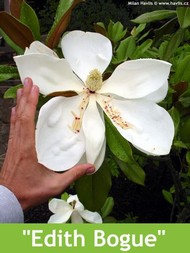 Another cultivar with an interesting history is 'Edith Bogue'. The story goes that one very harsh winter in northern New Jersey, USA, Mrs Bogue froze almost all of her large-flowered magnolias at temperatures of around -30°C. There was only one left that was thriving, so she tried to propagate it. She soon discovered that nature had sent her a very hardy clone, which must have made her a millionaire, as she patented it and propagation is subject to a paid licence. It bears large flowers as well as leaves.
Another cultivar with an interesting history is 'Edith Bogue'. The story goes that one very harsh winter in northern New Jersey, USA, Mrs Bogue froze almost all of her large-flowered magnolias at temperatures of around -30°C. There was only one left that was thriving, so she tried to propagate it. She soon discovered that nature had sent her a very hardy clone, which must have made her a millionaire, as she patented it and propagation is subject to a paid licence. It bears large flowers as well as leaves.
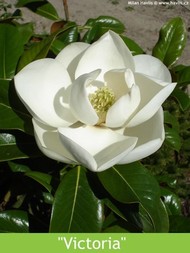 Botanists in British Columbia, Canada, have not been idle and have also produced a hardy variety which competes successfully with Edith Bogue, as it also resists severe frosts and enthusiastic growers argue over which is more resistant to winter heat without significant damage to the leaves. She was named 'Victoria'. The flowers here are also very large, the leaf buds are pink and the leaves are 20-30 cm long. Propagation of this species is also subject to a paid licence, so you will usually see a higher price for these two varieties. In any case, these are proven species that do not need to be protected for the winter.
Botanists in British Columbia, Canada, have not been idle and have also produced a hardy variety which competes successfully with Edith Bogue, as it also resists severe frosts and enthusiastic growers argue over which is more resistant to winter heat without significant damage to the leaves. She was named 'Victoria'. The flowers here are also very large, the leaf buds are pink and the leaves are 20-30 cm long. Propagation of this species is also subject to a paid licence, so you will usually see a higher price for these two varieties. In any case, these are proven species that do not need to be protected for the winter.
'Exmouth' is a very hardy cultivar which has been successfully spreading to the more northern parts of Italy, the UK and the USA. It can withstand frosts down to about -25°C and has slightly smaller and more compact growth, so you can afford it if you have a medium-sized garden.
And if you have a really small garden, the 'Little Gem' variety with 15-20 cm diameter flowers is ideal for you. It grows slowly and densely. But it is a slightly more delicate variety, tolerating about -20°C in the leaves and -25°C in the wood.
The variety 'Goliath (Praecox)' has become very popular in our country , which over the years of cultivation in our conditions has shown a stronger hardiness than is commonly reported on the internet (about -23°C to -25°C), and moreover it flowers at a young age and buds form continuously throughout the summer until the last warm days of early autumn.
Growing large-flowered magnolias is not difficult, although they naturally require more care than, say, spruce. You need to be aware of where it comes from and what it needs. The first important thing is location. It needs plenty of sun and a warm habitat to flower profusely. In Bohemia we have warm summers and long enough for the plants to mature and form flowers, which is an advantage. It is certainly worth considering, despite its good hardiness, to find a place protected from the strongest winds that would dry out its leaves in autumn and winter. It likes high humidity, which we can't imitate here, so we'll at least think about getting enough root fogging and keeping the ground moist (not wet!). Soil reaction is not important, although it is true that acidic soil (with peat) better helps the plant to absorb the iron so important for leaf colour. Older plants like clay until they grow their own roots to it. It is demanding of the nutrients in the soil, so we recommend applying some soluble starter fertilizer in two doses about 10 days apart in the spring and applying a long-lasting, slow-soluble fertilizer in late spring in an amount appropriate to the size of the plant, preferably Osmocote. Care for winter: be sure to pile on plenty of bark on the roots so that the roots freeze as late as possible.
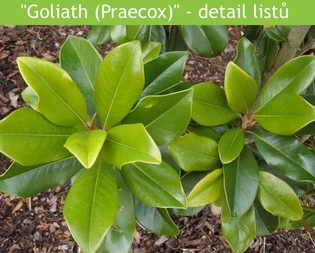 As it is a deciduous plant, its leaves evaporate water even in winter. If the roots freeze, it has nothing to absorb water from the ground and in prolonged strong sunlight or freezing winds it automatically drops its leaves, which it cannot nourish = water. We therefore advise that in temperatures below -25°C, wrap the plant in a white non-woven fabric for the shortest period of time, usually a maximum of 14 days, then unwrap the plant immediately to prevent it from wilting. This protection should be repeated for about 3 winters after planting, until the plant is well established and ideally the main root has sunk to an unfrozen depth from which it can draw water even in the freezing months. This is where the advantage of the aforementioned cultivars such as Edith Bogue, Victoria and even Exmouth, which are not packed for the winter, becomes apparent, as the circulation of water in the plant and its evaporation from the leaves is limited.
As it is a deciduous plant, its leaves evaporate water even in winter. If the roots freeze, it has nothing to absorb water from the ground and in prolonged strong sunlight or freezing winds it automatically drops its leaves, which it cannot nourish = water. We therefore advise that in temperatures below -25°C, wrap the plant in a white non-woven fabric for the shortest period of time, usually a maximum of 14 days, then unwrap the plant immediately to prevent it from wilting. This protection should be repeated for about 3 winters after planting, until the plant is well established and ideally the main root has sunk to an unfrozen depth from which it can draw water even in the freezing months. This is where the advantage of the aforementioned cultivars such as Edith Bogue, Victoria and even Exmouth, which are not packed for the winter, becomes apparent, as the circulation of water in the plant and its evaporation from the leaves is limited.
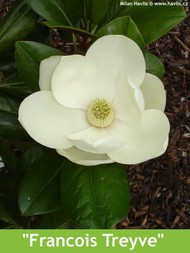 New for 2011 is the sensational 'Francois Treyve' variety . I deliberately state that this is a new release because otherwise this lady is over 100 years old. It was found at the end of the 19th century by the French gardener Francois Treyve in Auvergne and since it could withstand the harshest winters of 1870 and 1880, he decided to propagate and grow it in the colder regions of France. The success with hardiness was amazing, but propagation was disappointing as this beauty is very difficult to reproduce. For this reason it is still considered a rarity in Europe. It has rounder leaves and slightly smaller flowers, very similar to the 'Victoria' variety. The growth is narrower and more compact. It copes well with winter sun and tolerates up to -25°C without protection. In the French arboretum de Balaine it survived the lowest temperature of -28°C, but sources no longer indicate whether the frost damaged its leaves. Even so, it is a hot pick for the hardy evergreen magnolia family.
New for 2011 is the sensational 'Francois Treyve' variety . I deliberately state that this is a new release because otherwise this lady is over 100 years old. It was found at the end of the 19th century by the French gardener Francois Treyve in Auvergne and since it could withstand the harshest winters of 1870 and 1880, he decided to propagate and grow it in the colder regions of France. The success with hardiness was amazing, but propagation was disappointing as this beauty is very difficult to reproduce. For this reason it is still considered a rarity in Europe. It has rounder leaves and slightly smaller flowers, very similar to the 'Victoria' variety. The growth is narrower and more compact. It copes well with winter sun and tolerates up to -25°C without protection. In the French arboretum de Balaine it survived the lowest temperature of -28°C, but sources no longer indicate whether the frost damaged its leaves. Even so, it is a hot pick for the hardy evergreen magnolia family.
This almost exclusive tree is offered in several sizes, so perhaps everyone who loves it can find the right one for their garden. It's definitely worth the price and I'm advocating for adding another beautiful tree to our beautiful grounds myself.

































